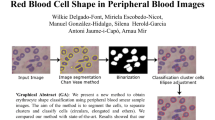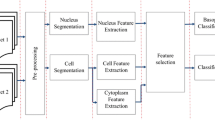Abstract
In sickle cell disease the cell morphology analysis is used to diagnose due the deformation of the red blood cell caused by the disease. Previous works used, in images of peripheral blood samples, ellipse adjustment and concave point detection due to the elongated shape of the erythrocyte and obtained good results the detection of cells that were partially occluded in cells’ clusters. In this work, we propose a new algorithm for detecting noteworthy points in the ellipse adjustment and the use of Hidden Markov Model (HMM) for automatic erythrocyte supervised shape classification in peripheral blood samples. Furthermore, in this study we applied a set of constraints to eliminate the image preprocessing step proposed in previous studies. The method was validated using peripheral blood smear samples images with normal and elongated erythrocytes. In all the experiments, in the classification of normal and elongated cells the sensibility was superior to 96 %.
Access this chapter
Tax calculation will be finalised at checkout
Purchases are for personal use only
Similar content being viewed by others
References
Rabiner, L.: Quantitative red cell morphology. Monogr. Clin. Cytol. 9, 1–27 (1989)
Bicego, M., Murino, V.: Investigating Hidden Markov Models capabilities in 2D shape classification. IEEE Trans. Pattern Anal. Mach. Intell. 26(2), 281–286 (2004)
Cai, J., Liu, Z.Q.: Hidden Markov Models with spectral features for 2D shape recognition. IEEE Trans. Pattern Anal. Mach. Intell. 23(12), 1454–1458 (2001)
Thakoor, N., Gao, J.: Detecting occlusion for Hidden Markov Modeled shapes. IEEE ICIP 2006, 945–948 (2006)
Palazón, V., Marzal, A., Vilar, J.M.: On Hidden Markov Models and cyclic strings for shape recognition. Pattern Recogn. 47, 2490–2504 (2014)
Zhu, Y., et al.: Coupling oriented Hidden Markov random field model with local clustering for segmenting blood vessels and measuring spatial structures in images of tumor microenvironment. In: IEEE International Conference on Bioinformatics and Biomedicine, pp. 353–357 (2011)
Qian, X., Byung-Jun, Y.: Contour-based Hidden Markov Model to segment 2D ultra-sound images. In: ICASSP 2011, pp. 705–708 (2011)
Min-Chi, S., Kenneth, R.: Hidden Markov Models for tracking neuronal structure contours in electron micrograph stacks. In: ISBI 2012, pp. 1377–1380 (2012)
Renuka, S., Min-Chi, S., Kenneth, R.: Hidden Markov Model-based multi-modal image fusion with efficient training. In: ICIP 2014, pp. 3582–3586 (2014)
Khan, A., Gould, S., Salzmann, M.: A linear Chain Markov Model for detection and localization of cells in early stage embryo development. In: 2015 IEEE Winter Conference on Applications of Computer Vision, pp. 527–533 (2015)
Ritter, N., Cooper, J.: Segmentation and border identification of cells in images of peripheral blood smear slides. In: ACSC 2007, vol. 62, pp. 161–169. Australian Computer Society Inc. (2007)
Habibzadeh, M., Krzyzak, A., Fevens, T.: Application of pattern recognition techniques for the analysis of thin blood smear images. J. Med. Inform. Technol. 18, 29–40 (2011)
Eom, S., Kim, S., Shin, V., Ahn, B.-H.: Leukocyte segmentation in blood smear images using region-based active contours. In: Blanc-Talon, J., Philips, W., Popescu, D., Scheunders, P. (eds.) ACIVS 2006. LNCS, vol. 4179, pp. 867–876. Springer, Heidelberg (2006)
Daz, G., González, F.A., Romero, E.A.: Semi-automatic method for quantification and classification of erythrocytes infected with malaria parasites in microscopic images. J. Biomed. Inform. 42(2), 296–307 (2009)
Gual-Arnau, X., Herold-García, S., Simó, A.: Erythrocyte shape classification using integral-geometry-based methods. Med. Biol. Eng. Comput. 53(7), 623–633 (2015)
Gual-Arnau, X., Herold-García, S., Simó, A.: Geometric analysis of planar shapes with applications to cell deformations. Image Anal. Stereology 34(3), 171–182 (2015)
Osher, S., Sethian, J.: Fronts propagating with curvature dependent speed: algorithms based on Hamilton-Jacobi formulations. J. Comput. Phys. 79, 12–49 (1988)
Ferri, F.J., Vidal, E.: Comparison of several editing and condensing techniques for colour image segmentation and object location. Pattern Recognition and Image Analysis, Series in Machine Perception and Artificial Intelligence. World Scientific Editorial (1992)
Stehman, S.V.: Selecting and interpreting measures of thematic classification accuracy. Remote Sens. Environ. 62(1), 77–89 (1997)
Ross, S.M.: Introduction to Probability Models, 11th edn. Elsevier, Amsterdam (2014)
González-Hidalgo, M., Guerrero-Peña, F.A., Herold-García, D., Jaume-i-Capó, A., Marrero-Fernández, P.D.: Red blood cell cluster separation from digital images for use in sickle cell disease. IEEE J. Biomed. Health Inform. 19(4), 1514–1525 (2015)
Rabiner, L.R.: A tutorial on hidden Markov models and selected applications in speech recognition. In: Proceedings of the IEEE, pp. 257–186 (1989)
Acknowledgements
This work was partially supported by the Projects TIN2012-35427, TIN2013-42795-P, with FEDER support, of the Spanish Government, and “XI Convocatoria de Ayudas Para Proyectos de Cooperación Universitaria al Desarrollo 2014 de la UIB”. The authors also thank the Mathematics and Computer Science Department at the University of the Balearic Islands for its support.
Author information
Authors and Affiliations
Corresponding author
Editor information
Editors and Affiliations
Rights and permissions
Copyright information
© 2016 Springer International Publishing Switzerland
About this paper
Cite this paper
Delgado-Font, W., González-Hidalgo, M., Herold-Garcia, S., Jaume-i-Capó, A., Mir, A. (2016). Erythrocytes Morphological Classification Through HMM for Sickle Cell Detection. In: Perales, F., Kittler, J. (eds) Articulated Motion and Deformable Objects. AMDO 2016. Lecture Notes in Computer Science(), vol 9756. Springer, Cham. https://doi.org/10.1007/978-3-319-41778-3_9
Download citation
DOI: https://doi.org/10.1007/978-3-319-41778-3_9
Published:
Publisher Name: Springer, Cham
Print ISBN: 978-3-319-41777-6
Online ISBN: 978-3-319-41778-3
eBook Packages: Computer ScienceComputer Science (R0)




